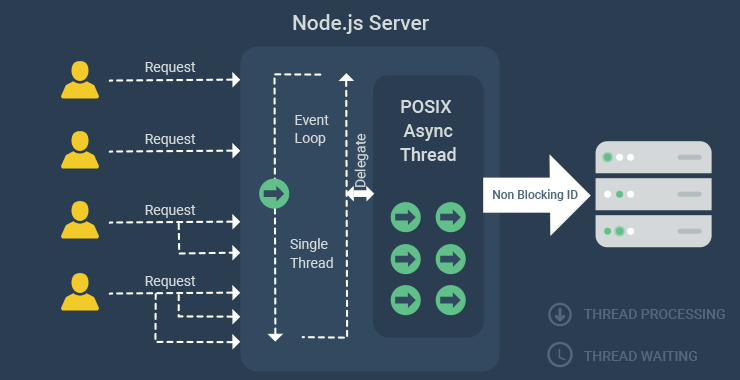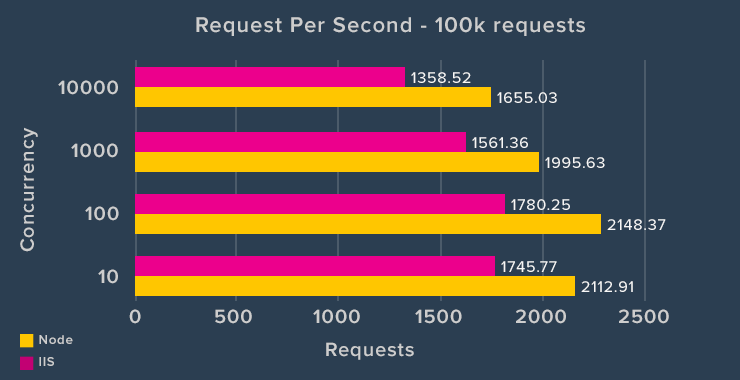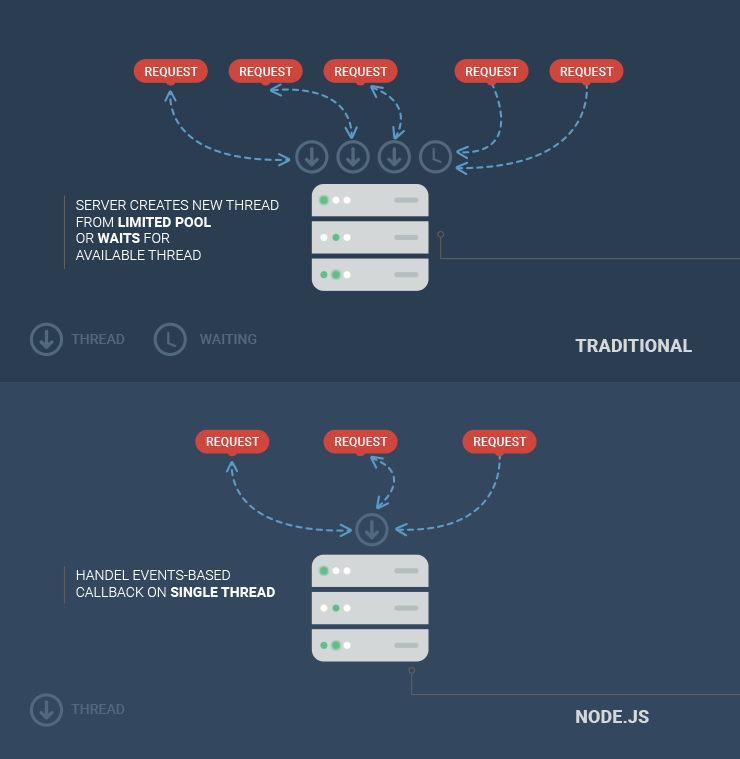Blog Tag: Node.js Development
Role of Node Js In Web Application Development By Using Microservices Architecture

Overcoming situations in the development process is, by itself, a challenging task for the developers. Now that several enterprises are opting for microservice architecture, Node js has a prominent role in development. This architecture lets the developers split the application into smaller blocks. These blocks can be developed individually, using various programming technologies, and helps developers to finish the entire task side-by-side in less time. Thus it aids in the agile and agnostic development process.
Node js is a run time environment based on Chrome’s V8 JavaScript engine. It is the go-to technology for startups, enterprises for its speedy development process.
Many leading companies are adopting Node js microservice like GoDaddy, Paypal, Netflix, and many more.
Advantages of Node js microservice
- Non-blocking, event-driven I/O model for top performance real-time web app development
- Allows creating, operating and handling services self-reliantly
- Cuts down much infrastructure so that teams can iterate swiftly
- Abundant modules are accessible for immediate use
- Enhances clarity among developers as they work on separate blocks of web application development. If it nosedives to perform during production, it can be effortlessly secluded and reconfigured
- Offer language and platform freedom for developers
- Efficient resource exploitation and expense optimization
Node js pros and cons are discussed as follows

The Pros:
- Node js supports JavaScript language on both the client and server-side. Thus, hiring separate backend and front-end developers can be avoided and reduce overhead costs.
- Offers top performance as V8 translates JavaScript code into machine code without the need for an interpreter. Also, the run-time environment proliferates the code execution speed tremendously by aiding non-blocking I/O operations.
- Dynamic Community of JavaScript programmers and their contribution is a great advantage.
- Concurrent Request Handling helps execute requests sequentially in a fast manner
- The advantage of caching is that it helps the application load web pages and respond to the user requests quickly, without needing the module code to be executed over again.
- Easy to learn, increases programmer productivity, code reusability, and consumes less time to work with it.
- It facilitates real-time application development like chat apps, games, chatbots, and voice user interface applications like Alexa.
The Cons:
- Unsteady API and the Echma script adds new syntax for writing complex applications, including classes and modules. Thus, programmers have to change the current code base to make it compatible with the Node js API’s latest version.
- It doesn’t have a standard library, and so it becomes hard to achieve regular programming tasks using Node js.
- Not appropriate for heavyweight computing apps As Node js is not supportive of multi-threaded programming yet.
Final Thoughts
Despite the limitations, Node js offers useful features to write several server-side applications, real-time Web APIs, and various networking applications in JavaScript. When it comes to Microservices, it is better first to decide if it suits your requirement from tech experts.
Being the leading Node js development company in the USA, we deliver the scalable solution to get into action soon. You can also hire developers for your project from the best web application development company. Touch base with our experts by calling: +1 408-400-3737
Frequently Asked Question
What is the purpose of Node?
Node lets the developers write code in JavaScript, which runs in a computer process directly instead of in a browser. Node is useful for writing server-side applications with access to the file system, operating system, and everything else necessary for creating fully-functional applications.
What is node js not suitable for?
Node js is not apt for developing heavy computing apps or for performing long-running calculations. It doesn’t support multi-threaded programming as of now. However, it can serve complicated applications more than Ruby. Heavy computations tend to block the inward requests, which results in a decrease in performance.
Is node js better than Java?
If your application involves running loops in millions of calculating tasks, then, in that case, Java will exceed node js. Node is lightweight due to the architecture based on events. It is developed to function as a web server and performs splendidly with servicing lightweight tasks.
Does node js have a future?
Node JS most likely won’t crush. But the chances are that it will match with various options and continue to develop. The future is bright in the front-end world for Node JS as it looks like no front-end development is conceivable without Node. Js, at least for the current time.
How to Use Node.js Architecture to Build Highly Scalable Apps?

Node.js is ideal for building highly scalable, data intensive, real-time back-end services that power our client applications. You might ask but there are other tools and frameworks out there for building back-end services such ASP.NET, Rails, Django, etc., why choose Node? Before answering the question, let’s understand Node.js architecture.
Node’s “Single Thread” Architecture
Node applications are highly scalable because of the non-blocking or asynchronous nature of Node. What do you mean by asynchronous? As a Node.js developer, let me give you an analogy.
You go to a restaurant. A waiter comes to your table, takes your order, and gives it to the kitchen. Then the waiter moves to serve another table while the chef is preparing your meal. The same waiter can serve many different tables and don’t have to wait for the chef to cook one meal before serving another table.
This is what we call non-blocking or asynchronous architecture and this is how Node applications work. The waiter is like a thread allocated to handle a request. So a single thread is used to handle multiple requests.
In contrast to non-blocking or asynchronous architecture, we have blocking or synchronous architecture. To understand the latter architecture, let’s go back to our restaurant analogy. You go to another restaurant, and in this restaurant, a waiter is allocated to you. The waiter takes your order and gives it to the kitchen. Now he is sitting in the kitchen waiting for the chef to prepare your meal, not doing anything.
One way to look at this analogy is this that the waiter is just waiting. He will not take an order from another table until your meal is ready. This is what we call blocking or synchronous architecture. Now, coming back to your question, that’s how applications built with frameworks like ASP.NET, Rails, and Django work out of the box.

In this architecture, when a server receives a request from the client, the thread is allocated to handle that request. As a part of handling that requests, the thread might query a database, which may take a little while until the result is ready. When the database is executing the query, that thread is sitting there waiting. It can’t be used to serve another client’s request and the server has to allocate it another thread.
If we have a large number of concurrent clients with their requests, at some point we’re going to runout of threads to serve these clients. New clients have to wait until free threads are available. If we don’t want them to wait, we need to add more hardware. That’s why Node.js development companies are in great demand these days.
A real-life example
The real-time chat app to support your helpdesk is based on blocking or synchronous architecture and, consequently, for each new conversation, the app creates a new thread. Let’s say each thread occupies 2MB of RAM and the server has 8GB of RAM installed. The RAM will max out at 4000 concurrent conversations. If you have managed a chat support center, then you know 4000 conversations at a time aren’t surprising. Upgrading server, we all know is a costly affair.

In contrast, a Node.js based real-time chat app can, virtually, achieve scalability levels of over 1M concurrent conversation on a single thread in the same amount of RAM. Of course, even the largest of support centers don’t process this many requests at a time. This is the magnitude of scalability a Node.js application can deliver.
Node’s “Single Thread” Advantage
In blocking or synchronous architecture, we are not utilizing our resources efficiently. That’s why applications built with frameworks like ASP.NET aren’t exactly scalable as they max out at the hardware’s maximum ram.
On the other hand, Node.js Platform uses “Single Threaded Event Loop” architecture to handle multiple concurrent clients. Node.js Processing model is JavaScript Event based model with callback. This is how the model works.

Node web server accepts requests and puts them in event queue. The web server continuously polls for new requests from client in an infinite loop called Event Loop. Event loop is at the heart of Node.js applications and gives them the unparalleled scalability I am talking about.
The event loop operates under single thread in Node. The event loop runs endlessly across the event queue, seeking new client requests. If it finds a new request in the queue, it will flag it as either blocking or non-blocking. The event loop will process the non-blocking request and send the response to user.
Things get a little interesting when the request requires server to perform a blocking I/O operation like accessing the file system or raising a SQL query. In that case, event loop assigns that request a thread and goes about polling for fresh requests in the event queue. The thread, in the meanwhile, processes the thread, performs blocking operations, and sends it back to the event loop with a response. The event loop sends the response back to the client.
An ideal architecture to build scalable apps
Asynchronous architecture makes Node ideal for building applications that include a lot of disk or network access. Your application can serve more clients without the need to throw in more hardware. Thus, Node.js applications are highly scalable.
